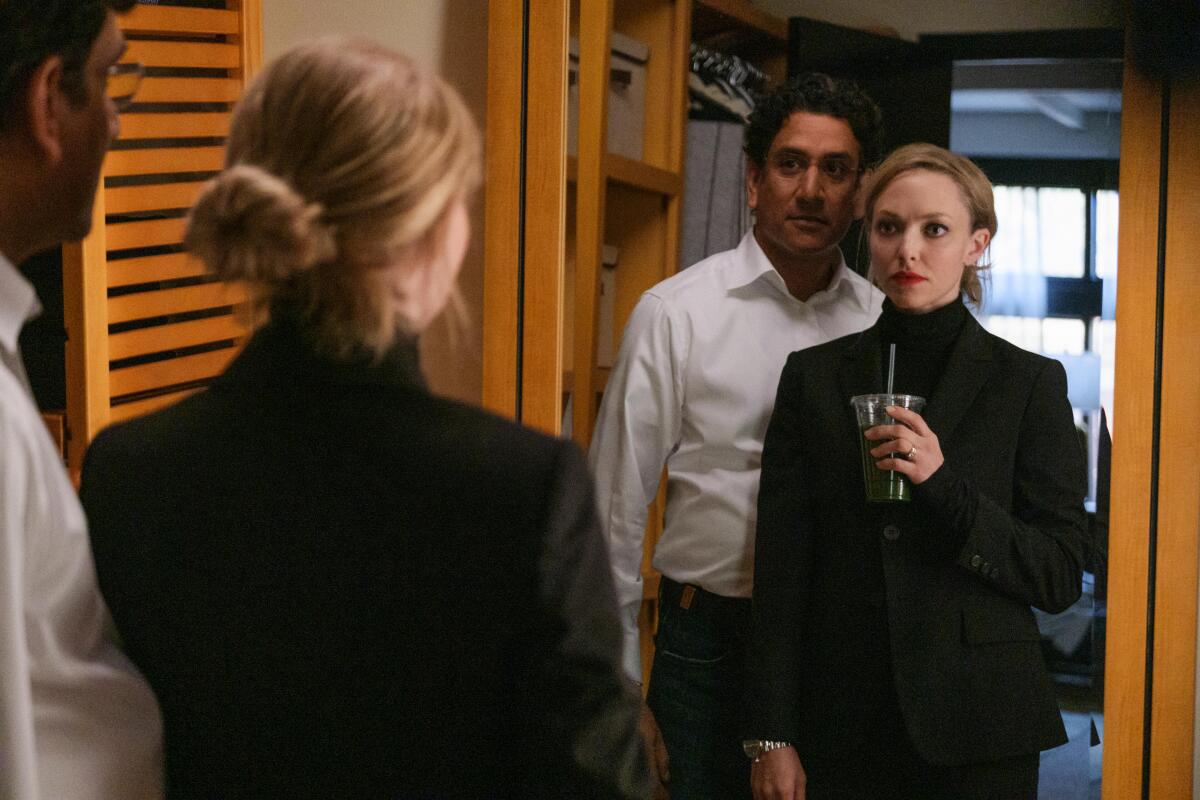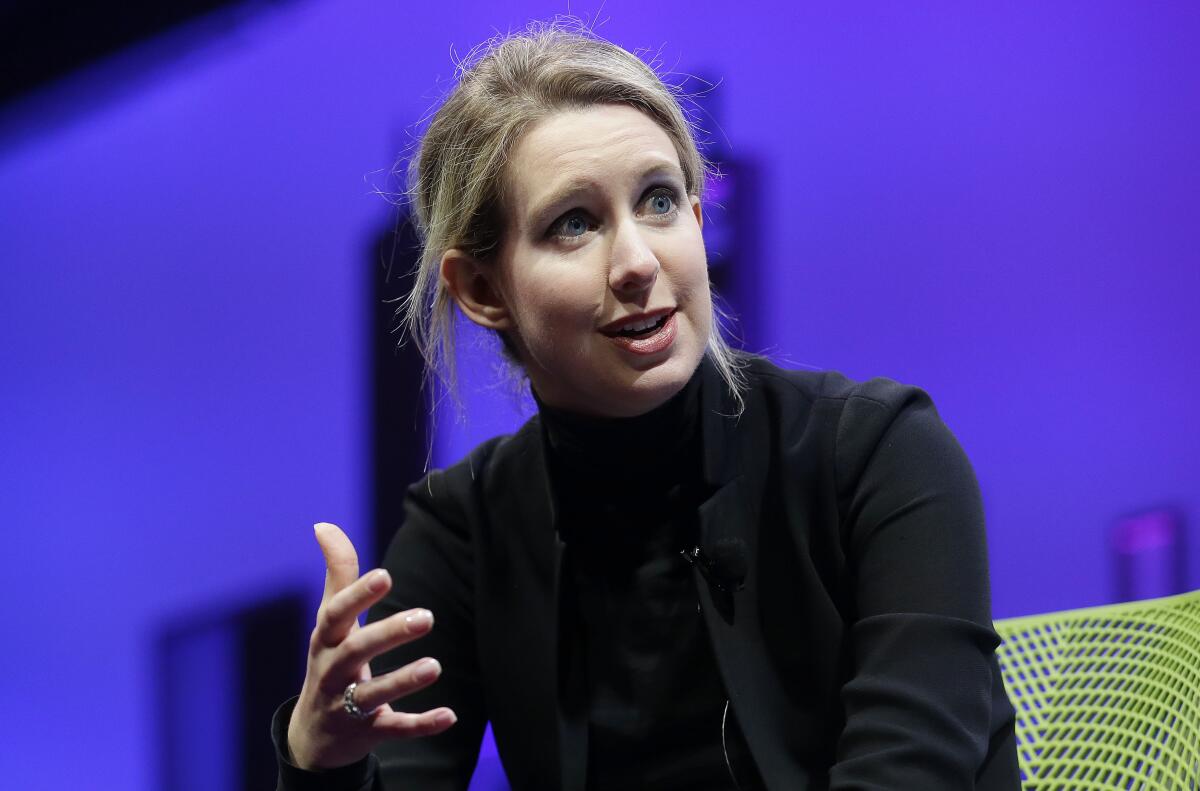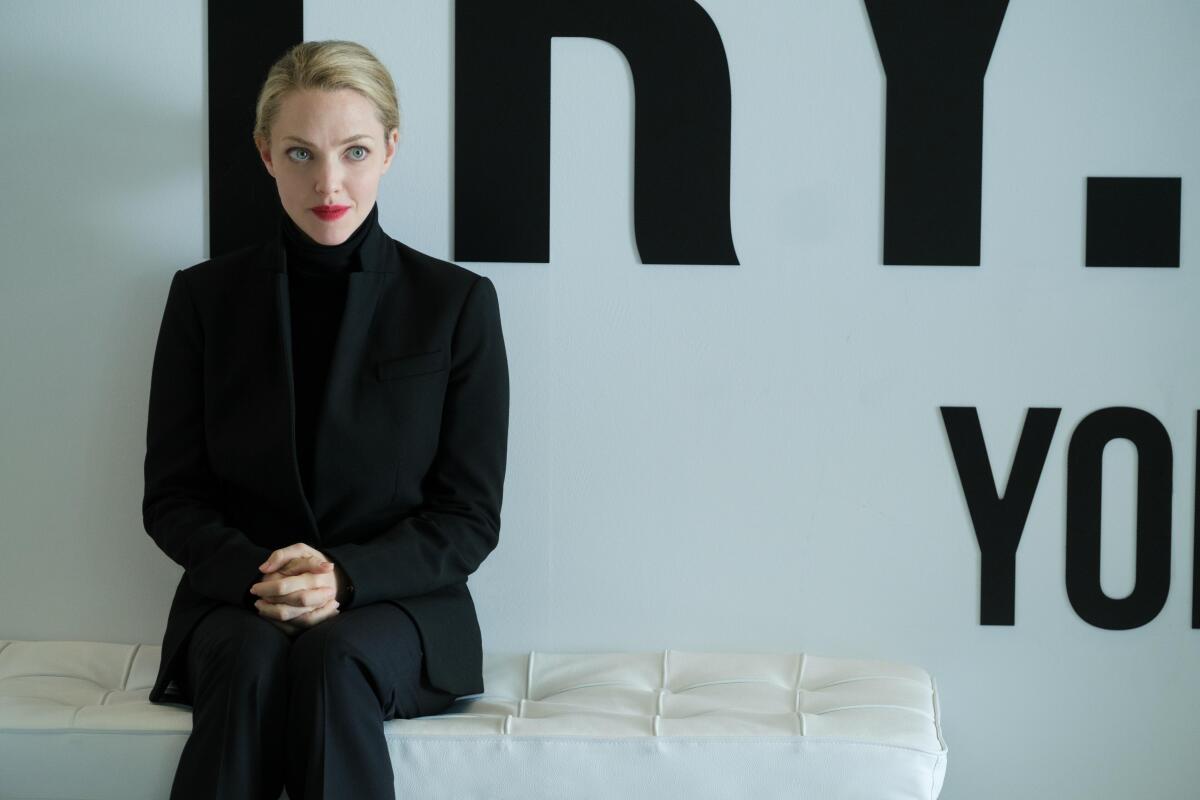How Amanda Seyfried found her (deep) voice as Elizabeth Holmes in ‘The Dropout’

- Share via
Amanda Seyfried is leaning into her computer’s camera for an impromptu tutorial. When it was announced that she would be playing disgraced Silicon Valley darling Elizabeth Holmes in a new Hulu limited series, most of the focus was on whether she could convincingly mimic Holmes’ famous deep baritone.
So, how did she do it?
“Keep your tongue flat in the back — like, flatten it over the back of your teeth,” she says, disapprovingly yet encouragingly, her wide eyes narrowing with focus as she observes me stumbling over these vocal Pilates.
“It’s funny, this is the first time I’m describing it like this because it became so natural,” she says, slipping in and out of the Holmes voice for emphasis. “I was used to it as a muscle memory. So yeah, it’s deeper. It’s like a kind of Valley girl almost.”
Based on the podcast of the same name, “The Dropout” tracks the rise and fall of Holmes and her biomedical company, Theranos. Seyfried portrays Holmes from her days as a Stanford student with Steve Jobs-level ambitions to her time as the enigmatic wunderkind who founded a blood-testing startup that promised to revolutionize healthcare with its ability to run hundreds of tests on just a few drops of blood — and was ultimately exposed as a con artist who bilked investors and patients by pushing technology that didn’t work.
At Theranos’ zenith, Holmes became known for her personal style, which seemed poised for mythmaking. Like Jobs, she adopted the black turtleneck, though she preferred pairing it with black pants rather than jeans and punctuated the monochromatic look with bright red lipstick. Her blond hair was usually ironed straight or pulled back into a messy chignon.
Showrunner Liz Meriwether explains how she found a dramatic through line in the ever-changing, often absurd case of the disgraced Theranos founder.
But no aspect of Holmes’ persona has fed into the public’s fascination more than what may be its most peculiar aspect: her deep voice.
Its authenticity has been called into question, with some alleging that the founder affected a lower tone to sound more authoritative while selling investors and the public on her company. In “The Dropout” podcast, former co-workers of Holmes said that she occasionally slipped out of her deep, low voice and spoke in a higher pitch. Her family has denied claims that it’s fake to TMZ.
The limited series takes the position that it’s part of the ruse. Seyfried’s take on Holmes’s distinctive voice comes barely a minute into the first episode of “The Dropout,” during a scene where she’s participating in an interview well into Theranos’ rise. But the narrative quickly journeys back to Holmes’ pre-Theranos, pre-voice origin story. It’s not until the third episode, “Green Juice” — which explores what it means to be a young woman in a position of power — where its genesis is dramatized.

And the transformation is anything but automatic. Liz Meriwether, the showrunner of the limited series, wanted the situation to dictate when Seyfried’s Holmes leaned into the uncanny pitch.
“That was something we consciously talked about — the voice is tied to the context [in which] it’s used,” Meriwether says. “We sort of made the decision that when she is in a public setting, when she’s around a lot of men, when she is being asked to be a leader, that’s when her voice really deepens. Then for the for the rest of it, it was like: Let Amanda play the scene and let it happen naturally. I didn’t want her to be thinking about it. I told her early on that getting it ‘perfectly right’ was not interesting, was not important to me. I was much more interested in the emotion of the performance.”
That didn’t stop Seyfried from putting in the demanding vocal work to try to match it, and under a tight schedule. Seyfried was tapped to play Holmes around this time last year after “Saturday Night Live” star Kate McKinnon pulled out of the project. Seyfried had three months to study for the role.
Getting it right was important to Seyfried because “people are always talking about the voice. It’s the first thing people mentioned. Second is the turtleneck; third is the non-blinking. But the voice is number one. The voice is the foundation. If you don’t, it’s like you’re missing the whole thing.”
“I went full force into finding out everything I could,” she added. “There was this huge [encyclopedia], that’s still actually on my desktop, of all the information that had been collected over the two years of research during the development phase of ‘The Dropout’ ... The thing that really helped with the voice and how that evolved for me was the deposition, because it was so many hours, and I could just play it on loop. I had them all on my desktop, little thumbnails. And I’d be sitting at my desk — at that time, my son was really, really young and he wasn’t mobile yet so it was a lot easier when my daughter was at school to just crochet and listen, or to just write things down. I felt like I was really doing homework, I was really studying. I was most excited about that, than any homework I ever had to do.”
The actress is video chatting from her home in the Catskills in upstate New York, joined by her Aussie-border collie mix Finn, who is lounging nearby. He’s heard plenty of Seyfried’s test runs as she found Holmes’ voice. Her farm animals even got a taste of it.
“I would like feed the goats in the morning and be like, ‘Good morning. Today, I’m, uh, going to get through this, uh, mixture of some mineral,’” Seyfried recalls, transitioning into the Holmes voice, something she did often during the conversation.

Seyfried would sometimes send her friends videos or voice memos that she recorded of herself speaking as Holmes at a TED talk or trying to sell something she dreamed up while driving for long stretches. And while Seyfried beams while talking about her fascination with voice work — “I’m a mimic. Sometimes I’m a good mimic, sometimes I’m not. But the more I hear someone’s voice, I can take it on” — she’s cautious to temper any expectations of a flawless Holmes imitation.
“It evolved into my version of it,” she says. “Because I know I’m not her twin, I’m not her, I’m not a clone of her. I needed to get it right and I needed to make sure that I could sustain it.”
While she didn’t work with her vocal coach, Liz Caplan, for this project — their collaboration tends to focus on singing — Seyfried did seek her advice early on because she was worried she was causing damage to her vocal cords.
The complete guide to home viewing
Get Screen Gab for everything about the TV shows and streaming movies everyone’s talking about.
You may occasionally receive promotional content from the Los Angeles Times.
“I would be talking like Elizabeth and [my throat would] get a little sore,” Seyfried says. “And I’d be like: this can’t happen. Like, this is freaking me out. Am I going to be able to do this for weeks? We worked together as much as we could. Sometimes we’d have to work together on weekends because I was auditioning for a musical. But, yes, at first I was f— scared.”
Seyfried describes Holmes as “ruthless, impenetrable and lost.” And figuring out the voice allowed Seyfried to do more than sound like Holmes — it brought her alter ego into focus. (Because of Holmes’ ongoing litigation, which resulted in her conviction on four counts of fraud earlier this year, Seyfried was unable to connect with her subject.)
“I think she didn’t feel like she was good enough on her own,” Seyfried says. “I think she felt like she had no choice but to make choices early on about how she was going to appear to the outside world, how she was going to deal with starting this business. In our show, it’s not like she was figuring out ways of speaking while she was in school. It all happened when she started this company. She needed to be the big bad boss. And there were certain elements to that that I think she understood to be really impactful, which is like, deepening your voice.
“Every choice she made was very deliberate at the time she made the choice. But I don’t know how deliberate it was at every single instance. I mean, when you start doing something enough times, it starts to become second nature — for all of us. She got on this train and it’s moving and she’s not getting off and she’s gonna work harder and faster and need more and get the job done at any cost. Did she need the voice? Maybe not. But I think she felt it was necessary.”
Whether or not it was necessary for Holmes, Seyfried’s fascination with her runs so deep that she’s held onto the voice.
“I still sometimes talk like her,” Seyfried says. “It’s hard to shake.”
‘The Dropout’
Where: Hulu
When: Any time
Rating: TV-MA (may be unsuitable for children under the age of 17)
More to Read
The complete guide to home viewing
Get Screen Gab for everything about the TV shows and streaming movies everyone’s talking about.
You may occasionally receive promotional content from the Los Angeles Times.








